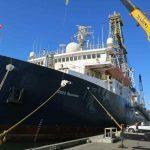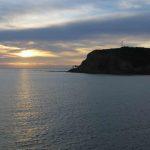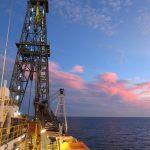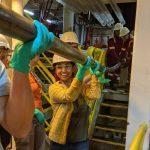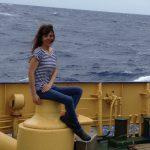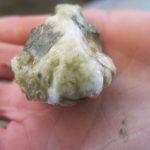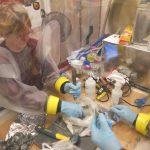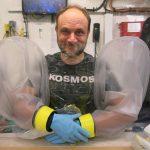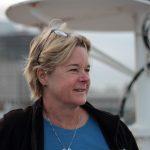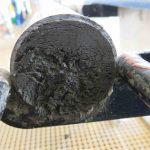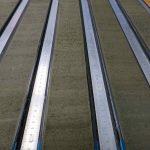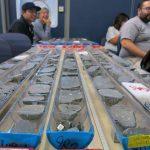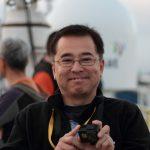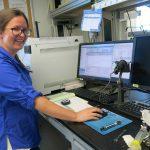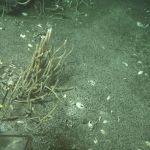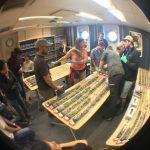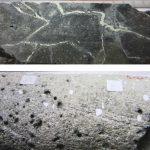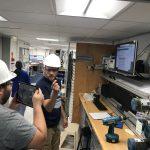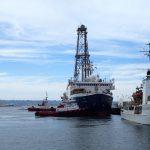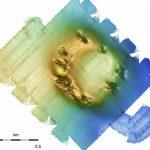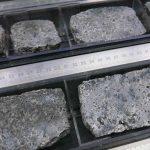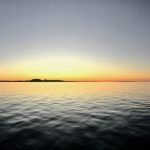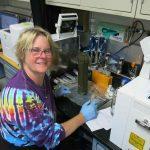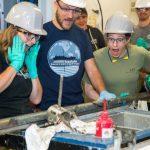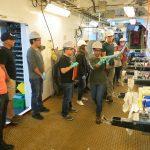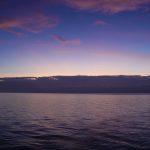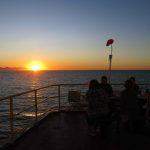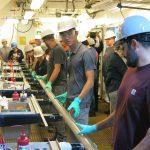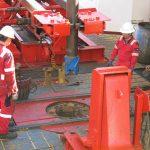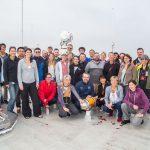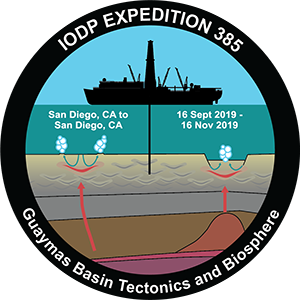
Guaymas Basin Tectonics and Biosphere
Texto en español abajo.
The Guaymas Basin, in the Gulf of California, is a very active area. It is a young spreading system (separating the Pacific and North American plates) where new seafloor is being created. At the same time, organic-rich sediments are rapidly being deposited on the seafloor from highly productive waters above. This is highly unusual for spreading centers — most of them are located far offshore in the open ocean where very little sediment accumulates.
In 2009, the Mexican National Commission of Natural Protected Areas declared the Guaymas Basin a sanctuary for its ecological and scientific relevance.
Magma forms in the upper mantle by seafloor spreading, and in the Guaymas Basin, that magma is being ‘trapped’ by the sediments before it would reach the seafloor. Here, these discrete pockets of hot magma rise up from the upper mantle and, at some depth, move sideways and then solidify into hot layers of intrusive magma rock — called sills — which are interlayered with the sediments.
The heat released from these sills as they cool and solidify changes the organic-rich sediments, releasing carbon dioxide, methane, petroleum, and other products. The heat also causes these products to be distributed throughout the subsurface and also to be released to the ocean water above.

Scientists have found that the magmatic sills in the Guaymas Basin also create large thermal and chemical gradients in the subsurface that are rich in energy. These gradients provide the elements to support microbial communities that thrive in the diverse ecological niches at and below the seafloor.
Microbes play a large role in the fate of carbon deposited in the Guaymas Basin. While certain species of microbes work to take up carbon and use it for producing their own biomass, others work to release carbon back to the ocean and atmosphere.
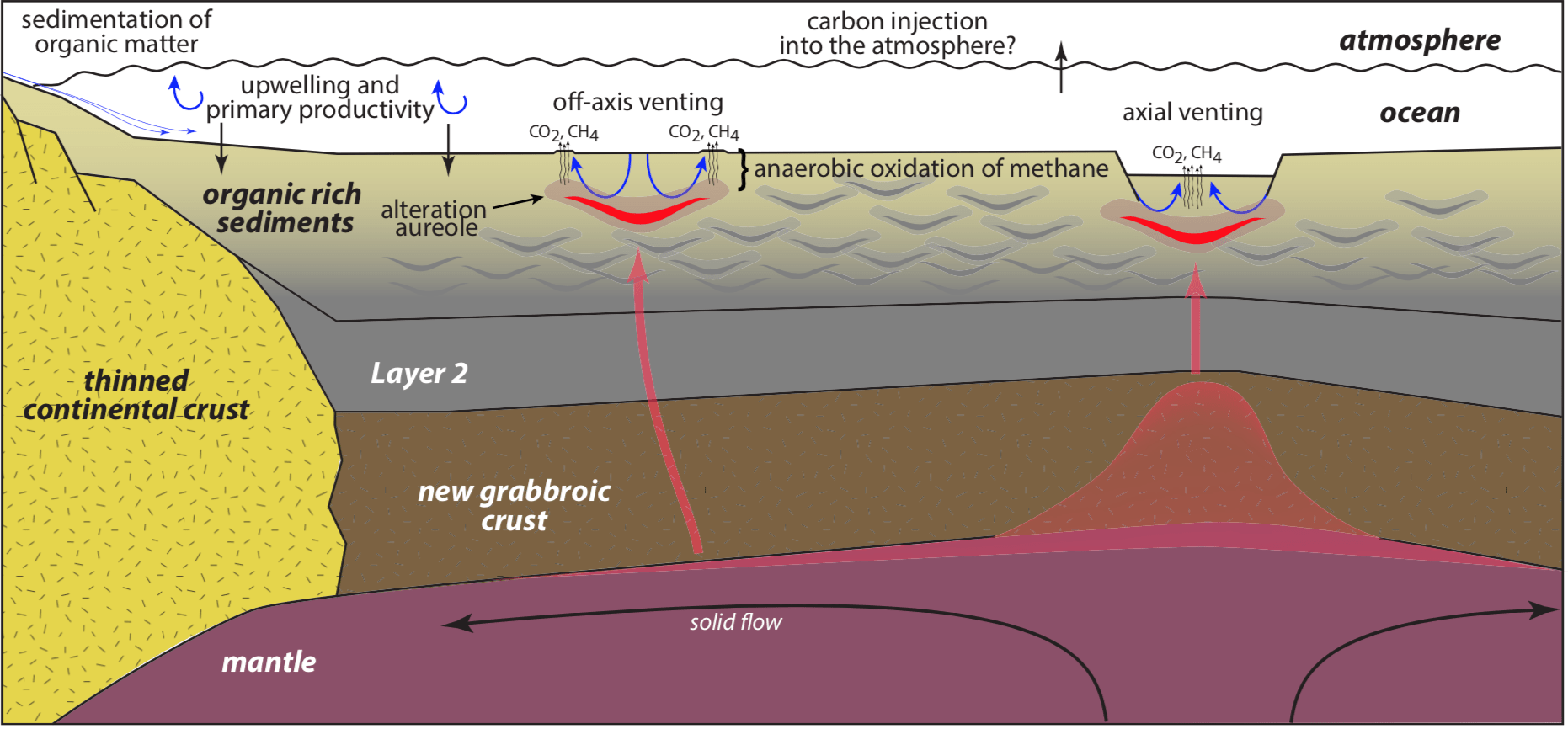
On Expedition 385, the JR will drill at key locations in successions of sediments and sills of varying age and temperature to explore the physical and chemical gradients along present and extinct fluid pathways. We will also investigate subsurface microbial communities that are sustained by the chemical compounds which are present below the seafloor. This will allow us to have a better idea of their efficiency at capturing these carbon-containing products and to advance our understanding of the conditions that limit life in the depth of our planet.
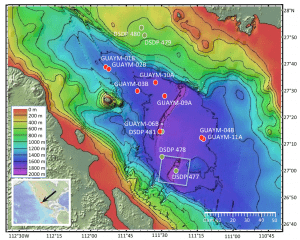
Make sure to follow this expedition on Twitter, Facebook and Instagram. We will also be posting on the American Geophysical Union’s Instagram account as guests every Thursday and Friday.
You can also find a list of blogs relating to this expedition below.
Co-chief Andreas Teske will also be blogging daily at expedition385.wordpress.com.
La Cuenca de Guaymas, en el Golfo de California, es un área muy activa. Es un sistema de expansión joven del fondo marino (que separa las placas del Pacífico y América del Norte) donde se está creando un nuevo fondo marino. Al mismo tiempo, sedimentos ricos en materia orgánica se están depositando rápidamente en el fondo marino debido a que las aguas son altamente productivas. Esto es muy inusual para los centros de expansión — la mayoría de ellos se encuentran lejos de la costa, en mar abierto, donde se acumula muy poco sedimento.
La Expedición 385 del JOIDES Resolution se centrará en estudiar el fondo marino de la Cuenca de Guaymas para conocer más sobre la tectónica y la vida microscópica de este sistema de expansión.
En 2009, la Comisión Nacional de Áreas Naturales Protegidas de México declaró que laCuenca de Guaymas es un santuario por su relevancia ecológica y científica.
El magma se forma en el manto superior (debajo de la corteza), y en la Cuenca de Guaymas, ese magma se queda “atrapado” por los sedimentos antes de que llegue al fondo marino. Aquí, estas formaciones discretas de magma caliente se elevan desde el manto superior y, a cierta profundidad, se mueven hacia los lados y luego se solidifican en capas calientes de intrusiones de magma, llamadas láminas, que se intercalan con los sedimentos.
El calor liberado de estas láminas a medida que se enfrían y solidifican cambia los sedimentos ricos en materia orgánica, liberando dióxido de carbono, metano, petróleo y otros productos. El calor también hace que estos productos se distribuyan por todo el subsuelo y también se liberen al agua del océano.
En investigaciones previas, los científicos han descubierto que las intrusiones magmáticas en la Cuenca de Guaymas también crean grandes gradientes térmicos y químicos en el subsuelo que son ricos en energía. Estos gradientes proporcionan los elementos para sostener comunidades de microbios que prosperan en los diversos nichos ecológicos sobre el fondo marino y debajo de él.
Los microbios juegan un papel importante en el destino del carbono depositado en la Cuenca de Guaymas. Mientras que ciertas especies de microbios trabajan para absorber carbono y usarlo para producir su propia biomasa, otros trabajan para liberar carbono de regreso al océano y la atmósfera.
En la Expedición 385, el JOIDES Resolution perforará el fondo marino en ubicaciones clave en sucesiones de sedimentos y láminas de diferentes edades y temperaturas para explorar los gradientes físicos y químicos. También investigaremos las comunidades microbianas subterráneas que son sostenidas por los compuestos químicos que están presentes debajo del fondo marino.
Esto nos permitirá tener una mejor idea de su eficiencia en la captura de estos productos que contienen carbono y avanzar en nuestra comprensión de las condiciones que limitan la vida en las profundidades de nuestro planeta.
Podrás seguir esta expedición en Twitter, Facebook e Instagram. También postearemos en la cuenta de Instagram de la American Geophysical Union como invitados cada jueves y viernes.
También podrás encontrar entradas de blog relacionadas con la expedición en la parte de abajo.
Además, el Co-Chief de la expedición, Andreas Teske, escribirá en su blog diario expedition385.wordpress.com.
Enjoy EXP385 social media videos here:
Expedition 385 in the media:
El Universal — Mexicanos perforan Golfo de California para estudiar la Tierra
Vanguardia — Mexicanos perforan el Golfo de California para estudiar la Tierra
10news — Renowned research ship docks in San Diego
KPBS — Research Vessel That’s Sailed The World Calls On San Diego Ahead Of Major Expedition
Times of San Diego — Unique Scientific Ship Docks in San Diego Before Gulf of California Expedition
El Imparcial — Perforarán Golfo de California para estudiar la historia de la Tierra
ThinkGeoenergy — Offshore research drilling to explore geothermal potential, Gulf of California, Mexico
Mexico News Daily — Scientists begin project studying ocean floor off Guaymas, Sonora
Jeotermal Haberler — Jeotermal potansiyeli kesfetmek icin acik deniz arastirma sondaji kaliforniya korfezi meksika
KUTV — メキシコの海の上から出前授業
Idowa — Ein Landshuter auf Tiefsee-Mission
Tumble Podcast — The Expedition of the Science Ship
Press releases
CICESE — El buque JOIDES Resolution, de crucero en el Golfo de California para estudiar la Cuenca de Guaymas
TAMU — President Young Tours JOIDES Resolution During Rare IODP Stateside Port Call
UABC — Participa estudiante de doctorado de UABC en expedición oceanográfica
Scripps Oceanographic Institute — Renowned Scientific Drilling Vessel with Ties to Scripps Visits San Diego
